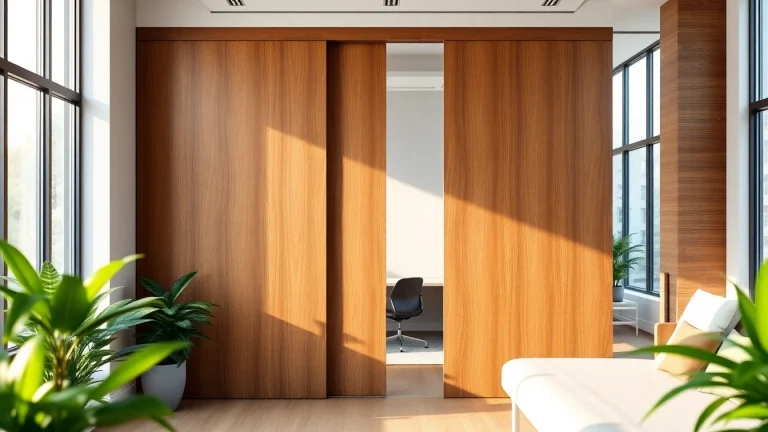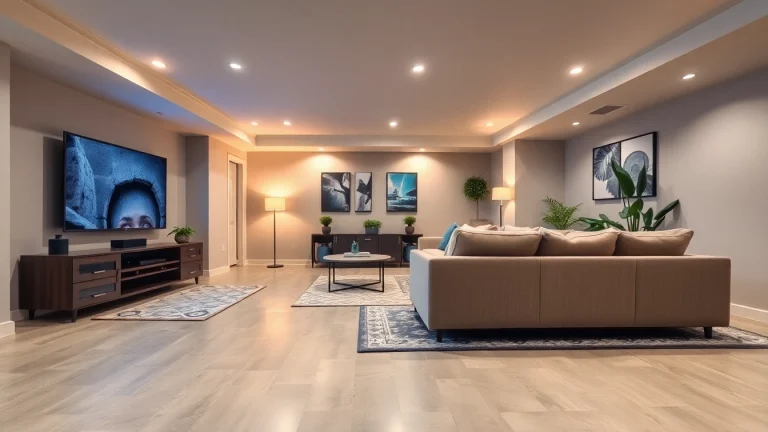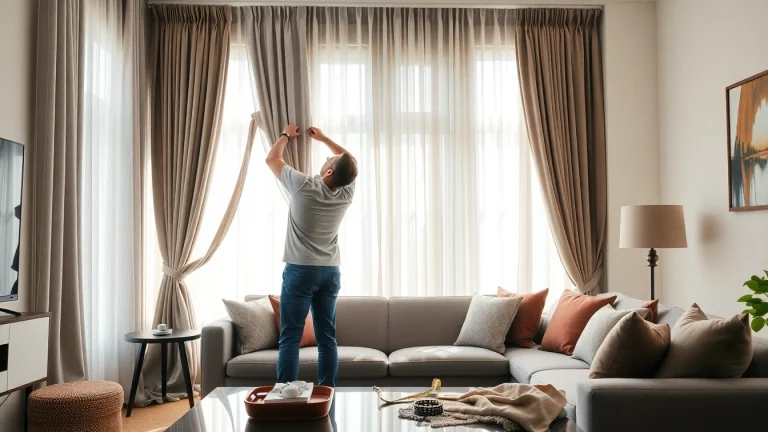
Enhancing Space Efficiency with Sliding Partition Walls: Design and Functionality
Understanding Sliding Partition Walls
What is a Sliding Partition Wall?
A sliding partition wall is a movable wall system that can be utilized to divide or subdivide spaces inside a building or an area. Unlike traditional fixed walls, sliding partition walls offer flexibility, allowing users to open or close off sections of a room as needed. These walls typically operate on a track system, enabling easy movement and reconfiguration of spaces, which is particularly useful in environments such as offices, schools, conference rooms, and even residential settings. As the demand for multifunctional spaces grows, the popularity of sliding partition walls continues to rise, emphasizing their utility in enhancing space efficiency.
Benefits of Sliding Partition Walls
The benefits of sliding partition walls extend beyond mere aesthetics and convenience. Here are some compelling advantages:
- Flexibility: The ability to create or eliminate separate spaces at will allows businesses and homeowners to adapt to varying needs without permanent changes.
- Cost-Effective: By avoiding extensive renovations or construction, sliding partition walls represent a more economical solution for space division.
- Acoustic Control: Many modern sliding partition systems come equipped with soundproofing capabilities, making them ideal for environments that require privacy and noise reduction.
- Customization: Sliding partition walls are available in various materials, colors, and designs, enabling personalized aesthetic integration into any decor.
- Space Optimization: They provide additional functionalities within a layout, helping to maximize every square foot with the ability to change layouts efficiently.
Common Applications in Various Spaces
Sliding partition walls can be utilized in a variety of environments, each with unique applications:
- Corporate Offices: Dividing large conference rooms into smaller breakout spaces for meetings or workshops.
- Educational Institutions: Creating flexible learning environments where classrooms can be resized based on student numbers.
- Residential Homes: Separating living areas from dining spaces or creating guest accommodations without the need for major renovations.
- Hospitality: In hotels, sliding partitions can create adaptable event spaces that can cater to different sizes of gatherings.
- Healthcare Facilities: Providing privacy for patients while still allowing flexibility for staff needs and patient flow.
Design Considerations for Sliding Partition Walls
Choosing Materials for Durability and Aesthetics
The choice of materials for sliding partition walls directly impacts both the durability and design of the installation. Common options include:
- Wood: Offers a warm, classic look and can be customized with finishes; great for residential applications.
- Glass: Provides a sleek, modern aesthetic and allows natural light to pass through, making spaces feel larger.
- Metal: Highly durable and can be used in commercial settings where strength and functionality are paramount.
- Fabric: Ideal for flexible surfaces that can be easily changed out or updated, offering versatility in design.
Understanding Size and Space Dynamics
Before installation, it’s crucial to understand the dimensions of the space where the partition wall will be placed. Considerations include:
- Height and Width: Measuring the available height and width is essential to select an appropriate partition wall that fits well and functions properly.
- Clearance: Ensuring there is enough room for the wall to slide without obstruction and that there are no ceiling fixtures in the path.
- Foot Traffic: Assessing how often individuals will need to transition between spaces helps determine functionality needs.
Customization Options for Unique Needs
The beauty of sliding partition walls lies in their customization. Different features can be tailored to meet specific requirements, including:
- Integrated Technology: Some systems can incorporate technology like automatic sensors or smart home integration for ease of use.
- Color and Finish: Choosing colors and finishes that align with existing design schemes enhances aesthetic appeal.
- Size Adjustments: Many systems allow for customizable sizes, ensuring that even unique spaces can be effectively managed.
Installation and Maintenance
Steps for Installing a Sliding Partition Wall
The installation of sliding partition walls, while often straightforward, requires attention to detail. Here is a generalized step-by-step guide:
- Assess the Space: Measure the area thoroughly and plan for the placement of tracks and any required fixtures.
- Choose Your System: Based on your measurements and design preferences, select the appropriate sliding partition wall system.
- Prepare the Track: Install the track securely according to the manufacturer’s instructions, ensuring it is level.
- Mount the Wall Panels: Hang the panels on the track, following the specified directions to ensure smooth operation.
- Test Operational Efficiency: Open and close the walls several times to ensure there are no obstructions and that the mechanism functions correctly.
Regular Maintenance Tips
Maintaining sliding partition walls is essential for longevity and performance. Suggestions for upkeep include:
- Regular Cleaning: Maintain clean tracks and wall surfaces to prevent clogs and ensure smooth operations.
- Inspect Mechanisms: Routinely check rollers and tracks for wear and tear, and replace any damaged components as necessary.
- Lubrication: Periodically apply a suitable lubricant to the tracks to ensure smooth sliding.
Common Installation Challenges and Solutions
While many installations go smoothly, some challenges may arise:
- Uneven Floors: Use shims to level the tracks if the flooring is uneven, ensuring a proper fit.
- Insufficient Wall Support: Ensure that the wall structure can support the weight of the partition; consider reinforcing if necessary.
- Alignment Issues: Take care during installation to keep panels uniformly aligned to prevent operational problems.
Sliding Partition Walls vs. Traditional Walls
Flexibility and Space Management
Unlike traditional walls that are permanent fixtures, sliding partition walls offer unparalleled flexibility. They allow for a dynamic space to evolve according to needs, enabling quick reconfigurations that traditional walls simply cannot provide. This adaptability can be critical in high-paced environments where versatility is key.
Cost Comparisons
In terms of cost, sliding partition walls are often more economical than traditional construction when considering initial outlay and future modifications. Installation of sliding systems tends to be quicker and less invasive, thus reducing labor costs and minimizing disruption to operations. Moreover, they can also save money in the long run by reducing the need for extensive renovations down the line.
Acoustic Performance Insights
Many sliding partition wall systems come with enhanced acoustic paneling that can significantly reduce noise transfer between spaces, which is a major consideration for offices, schools, and healthcare facilities. Comparing sound attenuation capabilities with traditional walls can reveal that well-designed sliding systems can meet or exceed those of standard constructions.
Trends in Sliding Partition Wall Design
Modern Aesthetic Trends
Minimalism continues to dominate modern design, with clean lines and unobtrusive materials being favored. Sliding partition walls are increasingly being designed to blend seamlessly into their environments, utilizing materials and finishes that complement rather than intrude upon overall design aesthetics.
Technological Innovations and Features
Innovation in sliding partition wall technology includes automatic systems that can be operated with a simple push of a button or apps that allow for remote control. Such advancements enhance user experience and further underline the versatility of these systems in both residential and commercial spaces.
Case Studies of Successful Implementations
Numerous organizations have successfully integrated sliding partition walls to enhance their spaces:
- Corporate Office: A tech firm used sliding walls to transform a large space into multiple collaborative zones, fostering teamwork without sacrificing the open office feel.
- School District: A series of sliding partitions were installed in a high school to enable flexible classroom arrangements, responding quickly to varying student numbers and class formats.
- Restaurant: A restaurant utilized partitions to create private dining experiences during peak times, optimizing client satisfaction and revenue potential.


